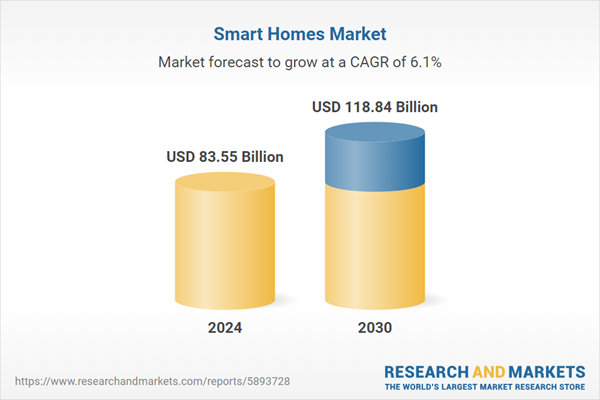Free Webex Call
The Smart Homes Market was valued at USD 83.55 Billion in 2024, and is expected to reach USD 118.84 Billion by 2030, rising at a CAGR of 6.05%. Smart homes are residential environments enhanced with internet-connected devices that enable automation and remote management of systems such as lighting, heating, security, and appliances. These devices interact through centralized hubs or mobile apps, offering control via smartphones or voice commands. Integrating artificial intelligence, wireless communication, and sensors, smart home technology creates an intelligent and responsive living space. The market includes the entire ecosystem of hardware, software, and services enabling these automated experiences. Rising Internet of Things (IoT) adoption, increasing demand for convenience, energy efficiency, and security, along with post-pandemic lifestyle shifts, are accelerating the global smart home trend. Speak directly to the analyst to clarify any post sales queries you may have.
10% Free customizationThis report comes with 10% free customization, enabling you to add data that meets your specific business needs.
Key Market Drivers
Rising Demand for Energy Efficiency and Cost Optimization
The pursuit of energy efficiency is a major driver in the smart homes market, as homeowners, utilities, and governments look to reduce energy consumption and operational costs. Smart home solutions - such as programmable thermostats, adaptive lighting, and automated HVAC systems - allow users to manage energy usage in real time based on occupancy and environmental conditions.These technologies not only lower utility bills but also contribute to sustainability goals. Additionally, utility companies are incentivizing the adoption of smart systems through demand-response programs that reward consumers for reducing peak-time usage. This integration of smart devices with energy management frameworks enhances grid reliability and offers consumers measurable savings. Moreover, energy analytics from connected homes support predictive maintenance and dynamic grid operations, providing a twofold benefit for both end-users and energy providers in an increasingly data-driven energy economy.
Key Market Challenges
Interoperability and Standardization Gaps Across Devices
The lack of universal standards and interoperability among smart home devices remains a significant hurdle in market adoption. With manufacturers using different communication protocols like Zigbee, Z-Wave, Bluetooth, and proprietary systems, consumers face challenges integrating various devices into a unified smart home setup. This fragmented ecosystem often leads to installation difficulties, inconsistent performance, and a poor user experience - particularly for non-technical users seeking seamless functionality. The inability to combine devices from multiple brands limits flexibility and discourages broader investment. For technology providers, this fragmentation demands continuous compatibility updates, increasing complexity and support requirements.Key Market Trends
Convergence of Smart Home Technology with Artificial Intelligence
The integration of artificial intelligence (AI) with smart home systems is a defining trend reshaping the market. AI-enabled devices can analyze usage patterns, learn user preferences, and proactively adjust settings to enhance comfort and efficiency. Smart lighting, climate controls, and voice assistants are evolving from reactive systems to predictive tools that anticipate user needs. This adaptive functionality enhances user satisfaction and promotes sustained adoption. On the business side, AI-powered platforms offer opportunities for service providers to introduce features like predictive maintenance, personalized automation, and subscription-based services. These intelligent systems support more intuitive and responsive living environments, setting new benchmarks for user interaction and operational performance in home automation.Key Market Players
- Amazon.com, Inc.
- Apple Inc.
- Alphabet Inc.
- Samsung Electronics Co., Ltd.
- LG Electronics Inc.
- Honeywell International Inc.
- Schneider Electric SE
- Siemens AG
Report Scope:
In this report, the Global Smart Homes Market has been segmented into the following categories, in addition to the industry trends which have also been detailed below:Smart Homes Market, By Product:
- Entertainment Devices
- Lighting Control
- Security & Access Control Systems
- HVAC
- Smart Kitchen Appliances
- Home Appliances
- Others
Smart Homes Market, By Software & Services:
- Behavioral
- Proactive
Smart Homes Market, By Sales Channel:
- Direct
- Indirect
Smart Homes Market, By Region:
- North America
- United States
- Canada
- Mexico
- Europe
- Germany
- France
- United Kingdom
- Italy
- Spain
- Asia Pacific
- China
- India
- Japan
- South Korea
- Australia
- Middle East & Africa
- Saudi Arabia
- UAE
- South Africa
- South America
- Brazil
- Colombia
- Argentina
Competitive Landscape
Company Profiles: Detailed analysis of the major companies present in the Global Smart Homes Market.Available Customizations:
With the given market data, the publisher offers customizations according to a company's specific needs. The following customization options are available for the report.Company Information
- Detailed analysis and profiling of additional market players (up to five).
This product will be delivered within 1-3 business days.
Table of Contents
1. Solution Overview
2. Research Methodology
3. Executive Summary
5. Global Smart Homes Market Outlook
6. North America Smart Homes Market Outlook
7. Europe Smart Homes Market Outlook
8. Asia Pacific Smart Homes Market Outlook
9. Middle East & Africa Smart Homes Market Outlook
10. South America Smart Homes Market Outlook
11. Market Dynamics
12. Market Trends and Developments
13. Company Profiles
Companies Mentioned
- Amazon.com, Inc.
- Apple Inc.
- Alphabet Inc.
- Samsung Electronics Co., Ltd.
- LG Electronics Inc.
- Honeywell International Inc.
- Schneider Electric SE
- Siemens AG
Table Information
| Report Attribute | Details |
|---|---|
| No. of Pages | 180 |
| Published | June 2025 |
| Forecast Period | 2024 - 2030 |
| Estimated Market Value ( USD | $ 83.55 Billion |
| Forecasted Market Value ( USD | $ 118.84 Billion |
| Compound Annual Growth Rate | 6.0% |
| Regions Covered | Global |
| No. of Companies Mentioned | 8 |









